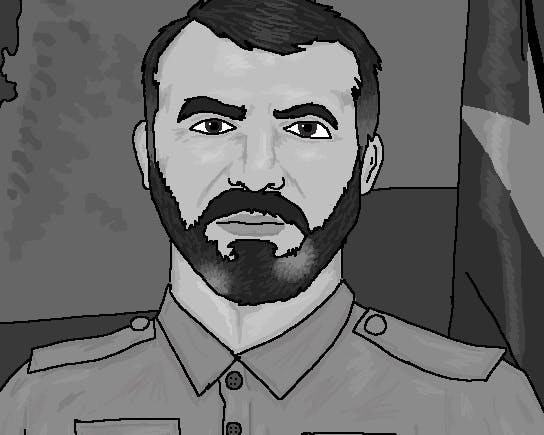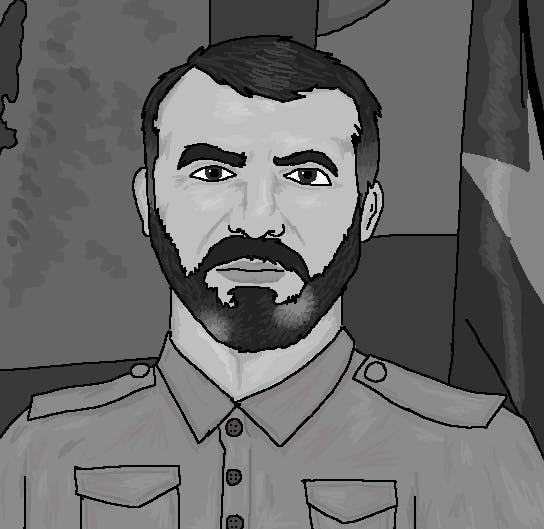'The Ghost': Meet the New Head of Hamas

Friday, 18 July 2025 | He’s not as dominant as Mohammed Deif or Yahya Sinwar, but after surviving six Israeli assassination attempts and emerging from a decimated leadership, Izz al-Din Al-Haddad—known by his nickname “The Ghost”—has become Hamas’ most senior figure in Gaza. Once a Fatah operative, Al-Haddad switched sides in prison and now reportedly holds veto power within Hamas.
Though he was never considered a natural successor, Al-Haddad has risen to prominence following Israel’s elimination of nearly all senior Hamas commanders. He’s not as publicly powerful as Mohammed Sinwar or Ahmed Randor, but in the vacuum created by the ongoing war, he’s become Hamas’s top operative on the ground.
A new photograph of Izz al-Din al-Haddad was released on Thursday by IDF Arabic-language spokesperson Lt. Col. Avichay Adraee. The image shows Haddad—previously seen in interviews and other public appearances—with dyed black hair and a significantly trimmed beard. According to Adraee, the photo was found inside a tunnel beneath the European Hospital in Khan Younis.

“The dramatic change in his facial features, as seen in the picture, reveals just one thing: deep fear and a desire to disguise himself and disappear. While Hamas promotes a narrative of ‘famine’ to the world, it appears that Haddad remains safe from it, far from the hunger and suffering experienced by the residents of Gaza,” according to Adraee.
Al-Haddad, 55, began his political life with Fatah in the 1980s and was imprisoned by Israel multiple times. During one of his stints in prison, he turned to Islamist ideology, joining Hamas upon release—a path also taken by former Hamas military chief Ahmed Jabari, who was assassinated in 2012.
Al-Haddad's stature grew after Israel's 2005 disengagement from Gaza, a moment that galvanized a new generation of Hamas military commanders and boosted their confidence.
Over the years, Al-Haddad held key positions. During Operation Cast Lead (2008–2009), he commanded Hamas battalions in eastern Gaza City. In 2012’s Operation Pillar of Defense, he oversaw Hamas’s southern brigades in Gaza City, and by May 2021’s Operation Guardian of the Walls, he was responsible for combat support operations across the Strip.
By the end of 2023, Israeli forces discovered documents and photographs in a raid on his home indicating tight command ties with subordinates, who reportedly revered him. He helped plan the October 7 massacre, overseeing the Gaza City sector and the deadly raid on Nahal Oz.
Although Israel failed in three recent attempts to eliminate him, two of Al-Haddad’s sons—including one active in Hamas’s military wing—were killed. His close aide and son-in-law Mahmoud Abu Hassira, who had participated in the 2014 attack on an IDF outpost that killed five soldiers, was also eliminated.
In November 2023, the IDF put a $750,000 bounty on Al-Haddad’s head, just below the sums offered for Marwan Issa and Mohammed Sinwar. Hours before the October 7 attack, Al-Haddad reportedly gathered six battalion commanders, giving them a handwritten message encouraging bravery and secrecy, banning cellphone use and instructing that their assaults be livestreamed.
During a January ceasefire interview with Al Jazeera, Al-Haddad claimed Israel had planned a massive assault after the Jewish High Holidays and that Hamas pre-empted it by launching their attack. He thanked Hezbollah, Iran and the Houthis for their support.
As the war progressed, Al-Haddad was promoted to commander of Hamas forces first in Gaza City and then across northern Gaza. After Mohammed Sinwar was killed, Al-Haddad naturally stepped into his shoes. His current focus includes appointing replacements for fallen commanders and managing ongoing military operations.
According to former hostage Keith Siegel, who met Al-Haddad several times in captivity, the commander asked after his well-being in fluent Hebrew. On the day of Siegel’s release, Al-Haddad gifted him chocolate and instructed him on how to behave for the cameras.
Some sources suggest Al-Haddad pushed for the January ceasefire due to the toll on his forces, but others argue he remains uncompromising, insisting on a full IDF withdrawal before any deal.
Unlike many Hamas commanders who avoid public appearances, Al-Haddad has appeared openly and even hinted at future attacks. In a 2022 video, he vowed Hamas would enter “the Holy Land,” boasting of rocket capabilities and surprise operations.
Despite his public appearances, little is known about Al-Haddad’s personal life. He enjoys popularity in Gaza, bears no known scandal and has lost family in the war—a factor that boosts his image. His low intelligence profile may have helped him survive.
The only other senior commander from the October 7 “core team” believed to still be alive is Raed Saad, who served as Hamas’s commander in northern Gaza. Saad, 53, comes from a refugee background and has a long record of militancy, including prison time and a role in developing Hamas’s rocket arsenal. He also helped establish Hamas’s military academy. Saad now heads Hamas’s operations division and is another high-priority target for Israel.
According to IDF intelligence, internal Hamas rivalries existed prior to the war. The Sinwar brothers led one faction, while Saad and Al-Haddad led another. In 2021, Saad backed Nizar Awadallah against Sinwar in a contested election that nearly unseated Sinwar—allegedly through fraud. After Sinwar’s elimination, Hamas appointed Al-Haddad to avoid internal strife, as he is seen as less controversial than Saad.
This power shift has altered Hamas’ decision-making model. Military operations are now run by Al-Haddad (as they were by Sinwar before him), while strategic decisions come from Hamas’s foreign leadership—especially figures originally from Gaza now based abroad, such as Khalil al-Hayya and others.
Despite war losses, Hamas remains Gaza’s dominant force. Young and inexperienced terrorists are filling the ranks, while veteran commanders like Hussein Fayyad and Haitham al-Hawajri—previously declared dead by the IDF—have resurfaced. Hamas’ internal security force continues to function, with its units carrying out executions of suspected collaborators and suppressing rival militias.
The Israeli assumption that Hamas is on the brink of collapse has yet to be realized. Instead of dismissing the terror group as finished, some analysts argue it’s time to reassess Hamas’ evolving power centers and strategies—and plan accordingly.
Dr. Michael Milshtein is an expert on the Palestinian Arena and the Head of the Palestinian Studies Forum at the Moshe Dayan Center for Middle Eastern and African Studies at Tel-Aviv University.
(This article was originally published by Ynetnews on July 18, 2025. See original article at this link.)
Related Resources

Discover Your Purpose and God’s Heart For You
In today's divided, turbulent world, it's essential for the Church to rediscover God's heart. Our free e-book, authored by a seasoned expert with three decades of experience in Israel, delves deep into the teachings of Jesus (Yeshua) to reveal God’s principles of love and purpose. Learn how embracing these truths can bring significance and impact to your life, even amidst chaos. Subscribe now to receive your free copy and embark on a journey of transformation.




